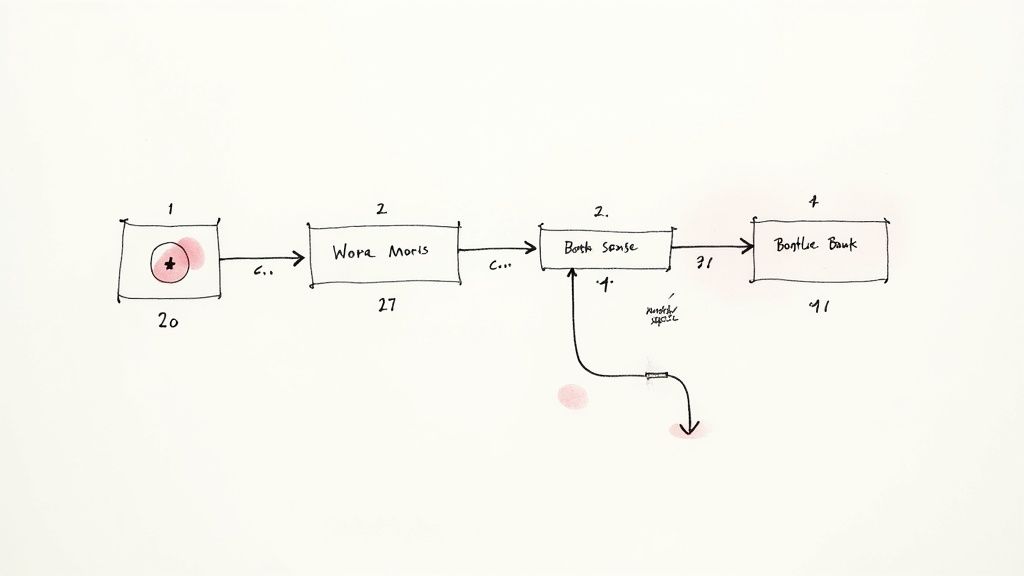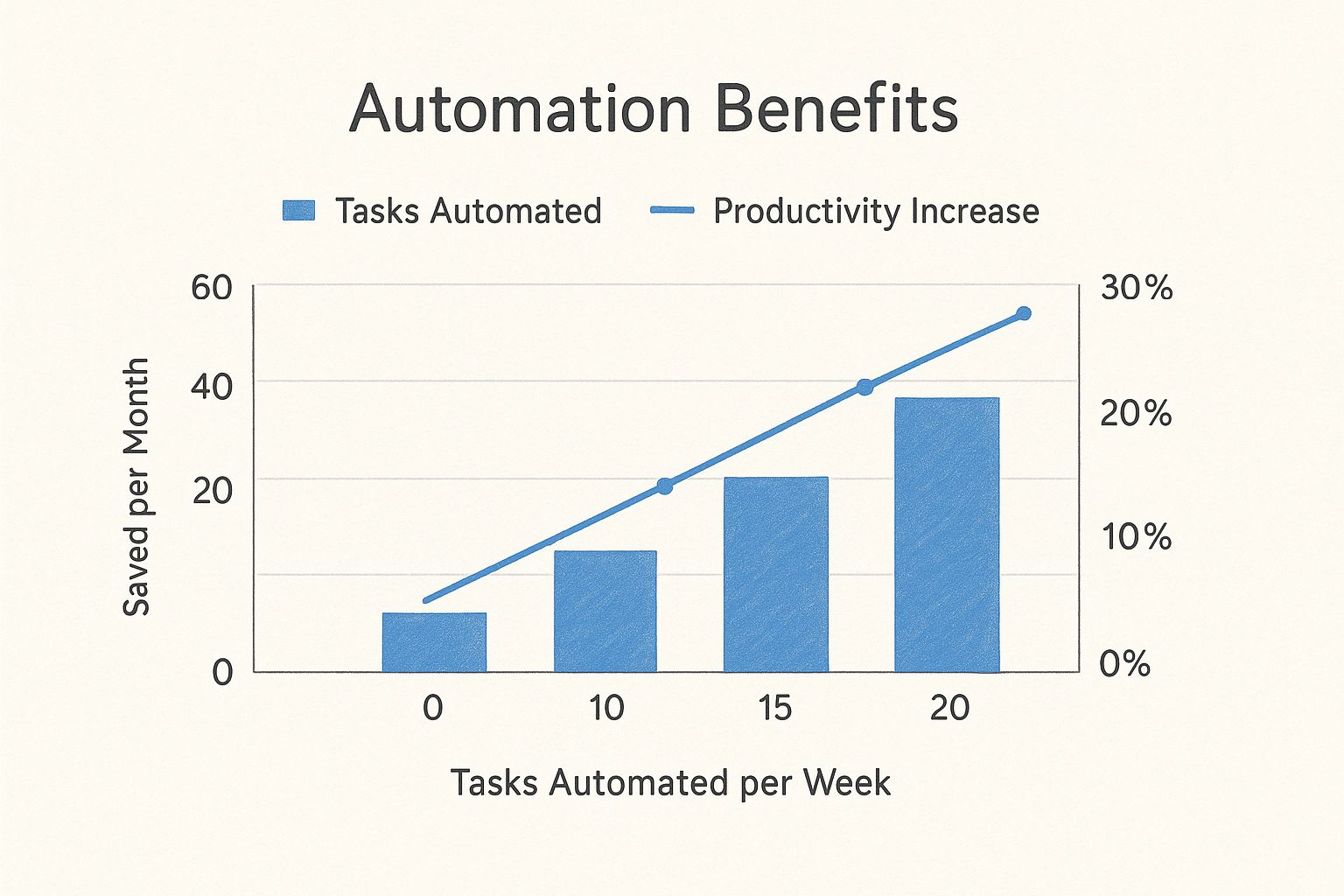
7 Tips to Improve Workflow Efficiency Effectively
Learn how to improve workflow efficiency with proven strategies and tools that boost productivity and streamline your business processes.

Why Workflow Efficiency Actually Matters for Your Bottom Line
Inefficient workflows can quietly drain resources and negatively impact team morale. These often appear as cumbersome processes that are accepted as "just the way things are." However, successful organizations recognize that optimizing workflows has a direct impact on their financial results. These organizations measure improvements in ways that executives understand: revenue growth, cost reduction, and competitive advantage.
For instance, seemingly small efficiency gains can add up to significant results. Consider reducing a daily task, performed by 10 employees, by just 5 minutes. This translates to nearly 40 hours saved each month. That's time that can be redirected to more valuable activities. Furthermore, reducing errors, a frequent benefit of streamlined processes, directly contributes to cost savings by minimizing rework and wasted resources.
The Real Cost of Inefficiency
Understanding the impact of operational efficiency on your business requires a close look at how to improve operational efficiency. Inefficient workflows often result in:
Lost Time: Employees spend valuable time on repetitive, manual tasks.
Increased Errors: Manual processes are more susceptible to human error, leading to rework and project delays.
Reduced Productivity: Frustration with inefficient systems can demotivate teams and hinder their output.
Decreased Profitability: All of the above contribute to increased costs and missed revenue opportunities.
This means that addressing workflow inefficiencies isn't simply about making things easier; it's a strategic investment in business growth and profitability. The increasing importance of workflow optimization is evident in the projected growth of the global workflow automation market. This market is forecast to reach US$18.45 billion by 2025, with roughly 75% of businesses recognizing workflow automation as a key competitive advantage. You can find more detailed statistics here.
From Cost Center to Profit Driver
High-performing organizations view workflow efficiency not as an expense, but as a source of profit. They understand that optimized processes free up resources, improve quality, and boost customer satisfaction. This translates to higher revenue, lower operational costs, and a stronger competitive edge in the market.
Simply implementing new tools, however, is not sufficient. True transformation requires a comprehensive approach that considers people, processes, and technology. The following section will explore practical strategies for mapping your current workflows without overburdening your team.
Mapping Your Current Workflows Without Getting Overwhelmed
Before you can optimize your workflows, you need a clear picture of what's actually happening. Often, our assumptions about how work gets done don't match reality. This section explores practical ways to document your existing workflows without putting too much strain on your team.

Visualization Techniques for Clarity
Effective operations leaders frequently use simple visuals to map workflows. These visual aids create a shared understanding of processes and can expose hidden bottlenecks. Flowcharts, for instance, clearly illustrate the sequence of steps and decision points within a workflow. Swimlane diagrams illuminate roles and responsibilities, pinpointing handoffs and potential communication issues.
Value stream mapping is another powerful technique. It identifies all steps in a process, distinguishing between value-added and non-value-added activities. This helps pinpoint areas where time and resources are wasted, revealing clear targets for improvement. Visual tools like these make it easier to understand and analyze even complex processes.
Stakeholder Interviews: Gathering Crucial Insights
While visualizations provide a broad overview, interviews with stakeholders offer valuable granular details. Talking to the people directly involved in a workflow uncovers their firsthand experiences and perspectives. This provides crucial insight into informal practices, undocumented workarounds, and pain points that might not be obvious through observation alone.
These interviews should be structured and focused. Instead of open-ended complaints, aim to understand the "why" behind each step, the challenges encountered, and the potential impact of changes. This ensures improvements address the root causes of inefficiency, not just superficial symptoms. You might be interested in: How to master efficient task management in Google Workspace.
Process Mining: Uncovering Hidden Bottlenecks
For data-rich organizations, digital process mining tools offer a robust method for mapping actual workflows based on system logs and transactional data. These tools automatically reconstruct processes, revealing deviations from established procedures and identifying bottlenecks in real-time. This data-driven approach provides accuracy and objectivity.
Process mining can expose unexpected process variations, highlight areas of non-compliance, and locate the exact points where delays occur. This data yields actionable insights for targeted improvements, ensuring your efforts to boost workflow efficiency are data-driven and have a real impact. It's important to remember that while technology can be helpful, many workflow mapping projects falter due to a lack of clear goals, insufficient stakeholder buy-in, and inadequate follow-through. Combining visualization techniques, stakeholder interviews, and data analysis provides a comprehensive understanding of current workflows, setting the stage for substantial improvements.
Automating The Right Tasks (And Avoiding Costly Mistakes)
Automating tasks is a powerful way to boost workflow efficiency. However, not all automation initiatives are created equal. Some can even backfire, creating more problems than solutions. The key is strategic automation, carefully selecting the right tasks based on factors like complexity, frequency, error rates, and strategic importance.
Identifying High-Impact Automation Opportunities
Successful organizations pinpoint high-impact automation opportunities by targeting repetitive, time-consuming tasks. These are often high-volume, low-variation activities, perfect for automation. Think data entry, report generation, and invoice processing. Automating these frees up employees to focus on more strategic work that demands creativity and critical thinking.
Tasks prone to human error are also prime candidates for automation. Automating these processes significantly reduces errors, improving data quality and minimizing rework. This translates to cost savings and greater efficiency. Order fulfillment, for instance, can be automated to reduce shipping errors, saving the time and resources normally spent correcting mistakes.

This infographic shows the impact of automating various numbers of tasks per week on monthly hours saved and percentage productivity increases. The upward trend clearly demonstrates the strong correlation between automation and enhanced workflow efficiency.
Avoiding Automation Pitfalls
Despite the clear benefits, some automation projects fall short. A common mistake is automating overly complex tasks that still require frequent human intervention. This can actually increase complexity and reduce efficiency. Another pitfall is automating infrequent or low-value tasks. The return on investment in such cases is often minimal, and resources could be better used elsewhere.
The Impact of Automation
The impact of automation on workflows is undeniable. Studies indicate that by 2025, 94% of companies will automate repetitive tasks. Kissflow reports that automation has improved jobs for 90% of knowledge workers and boosted productivity for 66% of them. The key to maximizing these benefits and avoiding costly errors lies in choosing the right tasks to automate. This strategic approach demands carefully evaluating a task's complexity, frequency, error rate, and contribution to business objectives.
To further illustrate the positive impact of automation, let's examine some typical results:
Introducing the table "Automation Impact on Workflow Metrics": This table highlights typical performance improvements achieved through workflow automation across different business functions.
| Business Function | Average Time Savings | Error Reduction | Cost Savings | Employee Satisfaction Impact |
|---|---|---|---|---|
| Customer Service (Ticketing) | 30% | 20% | 15% | Increased by reducing repetitive tasks |
| Sales (Lead Qualification) | 25% | 15% | 10% | Increased by allowing focus on relationship building |
| Marketing (Email Campaigns) | 40% | 25% | 20% | Increased by freeing up time for creative strategy |
| Human Resources (Onboarding) | 35% | 20% | 15% | Increased by streamlining paperwork and processes |
| Finance (Invoice Processing) | 50% | 30% | 25% | Increased by minimizing manual data entry and errors |
As the table demonstrates, automation can yield substantial improvements across a range of business functions. From significant time savings and error reduction to demonstrable cost savings and increased employee satisfaction, the strategic implementation of automation contributes to a more efficient and fulfilling work environment. By focusing on the right tasks, organizations can unlock the full potential of automation and drive meaningful improvements to their bottom line and employee morale.
Building Intelligent Workflows That Actually Learn
Automation helps boost workflow efficiency, but it’s not the end goal. The next step involves building intelligent workflows: processes that adapt, learn, and improve over time. This involves integrating data-driven decision points, predictive analytics, and continuous learning capabilities into your existing systems.
The Power of Data-Driven Decisions
Imagine a customer service workflow that automatically routes inquiries based on predicted complexity or urgency. Or picture a manufacturing process that adjusts production schedules based on real-time demand forecasts and potential supply chain disruptions. This is the power of data-driven workflows. By analyzing historical data and identifying patterns, these systems make smarter decisions, optimizing resource allocation and improving overall efficiency.
Predictive Analytics: Anticipating Future Needs
Predictive analytics enhances data-driven decisions. Instead of just reacting to current conditions, these systems anticipate future needs and proactively adjust workflows. For example, a sales team can use predictive analytics to identify high-potential leads, allowing them to prioritize their efforts and maximize conversion rates. To minimize errors, consider the benefits of document workflow automation. This helps teams focus on high-value tasks, ultimately improving workflow efficiency and driving business growth.
Continuous Learning: Adapting to Change
Truly intelligent workflows incorporate continuous learning. They constantly monitor performance, analyze results, and adjust their operations based on feedback. This adaptability is critical in today's dynamic business environment. As market conditions, customer behavior, and internal processes shift, intelligent workflows can evolve and optimize, ensuring sustained efficiency improvements. Integrating intelligent workflows has led to significant improvements in business activities. For example, in 2021, businesses using intelligent workflows reported better productivity, fewer functional silos, and greater cross-enterprise cohesion. 55% of respondents reported optimized productivity, while 52% noted reduced silos and increased integration. Learn more here.
Implementing Intelligent Workflows: A Collaborative Approach
Building intelligent workflows requires effective collaboration between non-technical teams and data specialists. Clear communication and a shared understanding of business goals are essential. Often, this involves developing frameworks and governance models to keep these systems aligned with organizational objectives as they develop. See also: How to master Kanban tasks and boost team productivity. Implementing intelligent workflows isn't just about new technology; it's about fundamentally changing how work gets done. By embracing data-driven decisions, predictive analytics, and continuous learning, organizations can unlock new levels of efficiency and build adaptive processes that thrive in a changing environment.

Transforming Communication That Unlocks Hidden Productivity
Inefficient communication can significantly impact workflow. It creates interruptions, leads to information overload, and slows down decision-making. High-performing teams recognize the importance of clear, concise, and timely communication. They implement strategies and use tools that optimize how information flows within their organization. This makes improving communication a critical factor in boosting overall workflow efficiency.
Choosing the Right Communication Tools
Effective communication starts with selecting the right tools for your team. Instant messaging platforms like Slack or Microsoft Teams are excellent for quick questions and real-time collaboration. For project-related discussions, project management software with built-in communication features, such as Asana or Trello, can centralize all relevant information. Email remains a valuable tool for formal announcements and important documentation. Choosing tools that integrate well with your existing processes will encourage adoption and ensure efficient information exchange.
Establishing Clear Communication Protocols
Having the right tools is only the first step. It's equally important to define when and how each communication channel should be used. This channel discipline minimizes distractions and prevents information overload. Urgent issues might warrant a phone call, while routine updates are better suited for email or project management software. Establishing clear guidelines on which tool to use for different types of communication ensures everyone is on the same page. Learn more in our article about How to master productivity in Google Workspace.
Combating Meeting Fatigue and Information Overload
Too many meetings and a constant stream of notifications contribute to meeting fatigue and information overload. These issues can drain productivity and negatively impact workflow efficiency. High-performing teams actively work to reduce unnecessary meetings and consolidate information. This might involve setting clear meeting agendas, limiting attendance to essential personnel, and utilizing asynchronous communication methods like shared documents or project updates.
Protecting Deep Work and Maintaining Transparency
Improving workflow efficiency requires a balance: supporting focused work while also promoting transparency and accountability. This means establishing clear expectations for response times and creating dedicated time for focused work, free from interruptions. At the same time, it's crucial to ensure open access to relevant information across departments. Centralized knowledge bases and regular project updates are effective ways to provide easily accessible information while minimizing disruptive communication. This allows teams to operate efficiently without sacrificing collaboration or transparency.
Measuring What Actually Matters in Workflow Performance

Many organizations focus on metrics that are easy to track, but don't necessarily reflect real progress. These vanity metrics can be misleading. Instead, to truly boost workflow efficiency, it's essential to measure the metrics that have a real impact. This means prioritizing results over simple activity.
Identifying Key Performance Indicators (KPIs)
The first step is to pinpoint the Key Performance Indicators (KPIs) that align with your specific organizational goals. These KPIs should directly relate to your business objectives.
For example, if your goal is faster customer support, a relevant KPI would be average resolution time. If you're focused on quicker order fulfillment, then time from order to delivery becomes a key metric.
But choosing the right KPIs is just the beginning. You also need to establish a baseline to understand your current performance level. This baseline serves as a benchmark to measure the effectiveness of your workflow improvements. Looking ahead, leading indicators can offer insights into future performance, allowing you to anticipate and address potential problems proactively.
Implementing Workflow Analytics: Avoiding Data Overload
While data is crucial, avoid overwhelming your team with unnecessary data collection. Concentrate on gathering information directly related to your chosen KPIs. This targeted approach ensures the data collected is relevant and actionable.
Tools like process mining software can automate data collection and analysis. These tools can map the flow of work, pinpoint bottlenecks, and highlight improvement opportunities without requiring manual data tracking.
Driving Continuous Improvement Through Regular Review Cycles
Workflow performance measurement isn't a one-time task; it's a continuous process. Regular review cycles are essential to analyze data, track progress, and identify areas for further refinement. These reviews should be opportunities to learn, adapt, and optimize your processes.
Use the data to refine workflows, adjust KPIs, and ensure continuous improvement. This iterative approach leads to sustainable workflow enhancements and contributes to long-term success.
To guide your measurement efforts, the following table outlines essential workflow efficiency metrics:
To make your measurement efforts easier, take a look at the table below. It outlines some essential metrics for workflow efficiency:
Essential Workflow Efficiency Metrics: Key performance indicators for tracking workflow improvement across different dimensions
| Metric Category | Key Metrics | Measurement Method | Target Improvement Range | Leading Indicators |
|---|---|---|---|---|
| Time-Based Efficiency | Cycle Time, Lead Time, Throughput | Time tracking software, Process mining tools | 10-20% reduction | Task completion rate, Automation adoption |
| Cost-Based Efficiency | Cost per unit, Labor costs, Resource utilization | Financial reports, Project management software | 5-15% reduction | Process automation level, Error rates |
| Quality-Based Efficiency | Error rates, Defect rates, Customer satisfaction | Quality control systems, Customer surveys | 10-20% improvement | Training completion, Process standardization |
| Employee Satisfaction | Employee feedback, Turnover rates | Surveys, HR data | 5-10% improvement | Streamlined processes, Reduced workload |
By measuring what truly matters, you gain valuable insights into your workflow performance. This allows you to identify areas for improvement and make changes that contribute to your organization's overall success.
Cultivating a Culture Where Efficiency Thrives
Even with perfectly designed workflows, genuine, lasting improvement requires a supportive organizational culture. This means fostering an environment where efficiency isn't a top-down mandate, but a shared value. This section explores how leading organizations build such cultures, focusing on practical strategies for long-term success.
Overcoming Resistance to Change
Implementing new workflows often encounters resistance. Employees may be comfortable with existing processes, hesitant about the unknown, or concerned about job security. Addressing these concerns proactively is essential.
Open communication about the why behind changes helps build understanding and buy-in. Highlighting the benefits for both the organization and individual employees—such as reduced workload, increased job satisfaction, and opportunities for professional development—can ease anxieties and create shared purpose.
Developing Internal Champions
Identifying and empowering internal champions greatly improves successful workflow adoption. These individuals advocate for changes within their teams, provide peer support, and offer valuable feedback.
They act as liaisons between management and frontline employees, facilitating smoother implementation and ongoing optimization. Their enthusiasm can inspire others to embrace new ways of working.
Rewarding Continuous Improvement
Incentivizing continuous improvement is crucial. Recognizing and appreciating employees who contribute to workflow optimization reinforces the importance of efficiency.
This can involve formal programs, performance bonuses, or simply acknowledging contributions during team meetings. This positive reinforcement encourages ongoing engagement and innovative thinking.
Balancing Standardization With Autonomy
Optimized workflows benefit from standardization, ensuring consistency and predictability. However, maintaining individual autonomy is equally important. This empowers teams to adapt to unique situations and refine processes.
Finding the balance between established procedures and flexibility is key to long-term efficiency. This means creating frameworks with clear guidelines while still encouraging adaptability and innovation.
Making Efficiency Part of Your Identity
Truly successful organizations embed efficiency into their identity. They share stories of improvement, celebrate wins, and model efficient behavior from leadership down.
Leaders play a vital role in showcasing the value of working smarter, not harder. This consistent message, combined with tangible results, cultivates a culture where efficiency thrives organically.
Ready to transform your workflows and unlock your team's full potential? Explore Tooling Studio's suite of powerful extensions designed to enhance productivity and collaboration within Google Workspace.